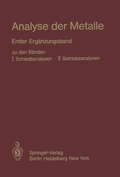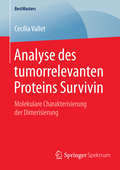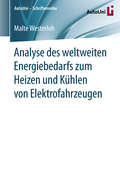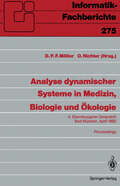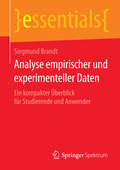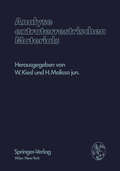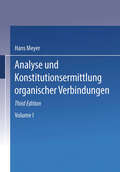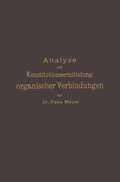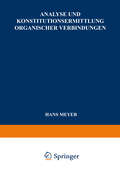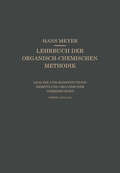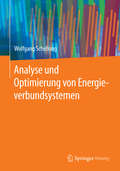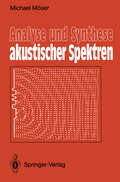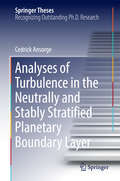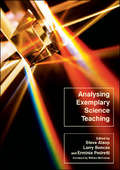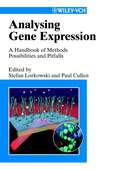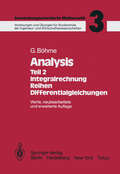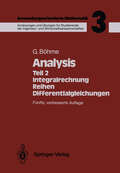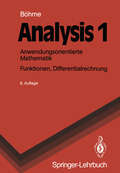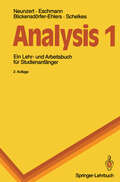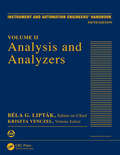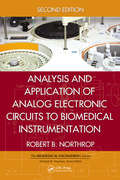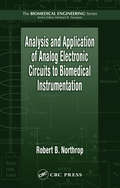- Table View
- List View
Analyse der Metalle: Erster Ergänzungsband zu den Bänden I Schiedsanalysen · II Betriebsanalysen
by Klaus WandelburgAnalyse des tumorrelevanten Proteins Survivin: Molekulare Charakterisierung der Dimerisierung (BestMasters)
by Cecilia ValletCecilia Vallet untersucht, wie der Wechsel zwischen der monomeren und der dimeren Form des Proteins Survivin reguliert ist. Survivin ist in nahezu allen malignen Tumorerkrankungen überexprimiert und durch seine Rolle als Zellzyklus-Regulator und Apoptose-Inhibitor an zwei entscheidenden Prozessen der Onkogenese beteiligt. Es wird angenommen, dass Survivin im Rahmen seiner Funktionen als Zellzyklus-Regulator und Apoptose-Inhibitor als Monomer agiert, wohingegen es in Lösung als Homodimer vorliegt.
Analyse des weltweiten Energiebedarfs zum Heizen und Kühlen von Elektrofahrzeugen (AutoUni – Schriftenreihe #138)
by Malte WesterlohDie Bewertung des weltweiten Energiebedarfs verschiedener HVAC-Systeme von BEV (Battery Electric Vehicle) basiert auf GREEN-MAC-LCCP für 211 Städte. Westerloh stellt für jede Stadt die Außenlufttemperatur, die relative Luftfeuchtigkeit und die Solarstrahlung unterteilt in sechs Temperaturbereiche mit der dazugehörigen gewichteten Häufigkeit dar. Der Autor bestimmt den Energiebedarf zum Heizen und Kühlen mit einem thermischen Gesamtfahrzeugmodell eines Elektroautos der Kompaktklasse. Die untersuchten HVAC-Systeme sind zwei Kälteanlagen mit Zusatzheizer mit den Kältemitteln R-1234yf und R-744 und zwei umschaltbare Wärmepumpen mit den Kältemitteln R-134a und R-744. Neben den Klimadaten verwendet Westerloh die Anzahl der zugelassenen Pkw und die durchschnittlich zurückgelegte Strecke pro Stadt zur Berechnung von Kenngrößen. Als Ergebnis erhält er den weltweiten Energiebedarf pro Kilometer und Pkw im Jahr sowie für eine BEV-Flotte für jedes HVAC-System in unterschiedlicher Auflösung. Die Kenngrößen diskutiert er mit Beispielen.Der Autor: Malte Westerloh arbeitet bei einem deutschen Automobilkonzern in der Methoden- und Prozessentwicklung für die virtuelle Absicherung. Er hat berufsbegleitend an der TU Braunschweig promoviert.
Analyse dynamischer Systeme in Medizin, Biologie und Ökologie: 4. Ebernburgerer Gespräch Bad Münster, 5.-7. April 1990 (Informatik-Fachberichte #275)
by Dietmar P. F. Möller Otto RichterAnalyse empirischer und experimenteller Daten: Ein kompakter Überblick für Studierende und Anwender (essentials)
by Siegmund BrandtDiese kompakte Einführung enthält die wichtigsten Grundlagen der mathematischen Statistik, die Beschreibung von Messungen und deren Fehler als Ergebnisse von Stichproben und die Methode der kleinsten Quadrate, angewandt auf verschieden schwierige konkrete Beispiele. Zusätzlich werden kurze Hinweise auf weitere Verfahren der Datenanalyse gegeben.
Analyse extraterrestrischen Materials: Herrn Professor Dr. Friedrich Hecht zu seinem 70. Geburtstag gewidmet
by W. Kiesl H. Jr. MalissaAnalyse und Konstitutions Ermittlung Organischer Verbindungen
by Hans MeyerDieser Buchtitel ist Teil des Digitalisierungsprojekts Springer Book Archives mit Publikationen, die seit den Anfängen des Verlags von 1842 erschienen sind. Der Verlag stellt mit diesem Archiv Quellen für die historische wie auch die disziplingeschichtliche Forschung zur Verfügung, die jeweils im historischen Kontext betrachtet werden müssen. Dieser Titel erschien in der Zeit vor 1945 und wird daher in seiner zeittypischen politisch-ideologischen Ausrichtung vom Verlag nicht beworben.
Analyse und Konstitutionsermittlung Organischer Verbindungen
by Hans MeyerDieser Buchtitel ist Teil des Digitalisierungsprojekts Springer Book Archives mit Publikationen, die seit den Anfängen des Verlags von 1842 erschienen sind. Der Verlag stellt mit diesem Archiv Quellen für die historische wie auch die disziplingeschichtliche Forschung zur Verfügung, die jeweils im historischen Kontext betrachtet werden müssen. Dieser Titel erschien in der Zeit vor 1945 und wird daher in seiner zeittypischen politisch-ideologischen Ausrichtung vom Verlag nicht beworben.
Analyse und Konstitutionsermittlung Organischer Verbindungen
by Hans Johannes MeyerDieser Buchtitel ist Teil des Digitalisierungsprojekts Springer Book Archives mit Publikationen, die seit den Anfängen des Verlags von 1842 erschienen sind. Der Verlag stellt mit diesem Archiv Quellen für die historische wie auch die disziplingeschichtliche Forschung zur Verfügung, die jeweils im historischen Kontext betrachtet werden müssen. Dieser Titel erschien in der Zeit vor 1945 und wird daher in seiner zeittypischen politisch-ideologischen Ausrichtung vom Verlag nicht beworben.
Analyse und Optimierung von Energieverbundsystemen
by Wolfgang SchellongDas interdisziplinär aufgebaute Buch bietet kommunalen Energieversorgern Hilfestellung, damit sie ihre Energieverbundsysteme analysieren und optimal steuern lernen. Es gibt einen Überblick über den Aufbau und die Komponenten von kommunalen Energieverbundsystemen. Die mathematischen und informationstechnischen Methoden zur Energiesystemanalyse werden umfassend beschrieben und an Praxisbeispielen erläutert. Es wird gezeigt, wie die Effizienz eines Kraftwerksverbunds mithilfe eines Energiecontrollingsystems analysiert und verbessert werden kann. Die dafür notwendigen Schritte zum Aufbau eines Energieinformationssystems werden detailliert dargestellt. Auch die mathematischen Methoden zur Analyse und Prognose des Energiebedarfs werden vorgestellt. Es wird gezeigt, wie diese Methoden zur Prognose der Stromlast und des Wärmebedarfs von Fernwärmesystemen genutzt werden. Aufbauend auf den Erkenntnissen der Energieanalyse werden Optimierungsaufgaben für Verbundsysteme abgeleitet und Lösungsansätze für die mathematische Optimierung dargestellt. Das Buch wird abgerundet durch eine zusammenfassende Beschreibung der Anforderungen für die Softwareentwicklung eines Energiemanagementsystems.
Analyse und Synthese akustischer Spektren
by Michael MöserDie Analyse und Synthese akustischer Spektren wird heute immer wichtiger in so verschiedenen Fachgebieten wie Sonar- und Radar-Technik, in der zerstörungsfreien Materialprüfung, in der medizinischen Ultraschall-Diagnose, in der Geophysik und in der Raumakustik des Ingenieurbaus. Der Autor liefert eine moderne Fourier-Spektrographie, deren zentrales Thema die Formung akustischer Spektren beinhaltet. Das Buch vermittelt die mathematischen und physikalischen Grundlagen und liefert Lösungsstrategien sowie Konstruktionshinweise für zusammengesetzte akustische Sender-/Empfänger- und Reflektor-Anordnungen zur Erzielung von in der Praxis besonders erwünschten Richtwirkungen (Synthese) bzw. von höchster Auflösung der Quellenkonfiguration anhand der mit wenigen Sensoren erfaßten Signale (Analyse). Der Autor ist um eine möglichst anschauliche, bildhafte und leicht verständliche Schilderung bemüht und gibt allen Themen konkrete Beispiele. Die geschlossene und ausführliche Abhandlung gibt dem Leser das Werkzeug zum eigenen Arbeiten an praktischen Problemlösungen in die Hand.
Analyses of Concept Learning
by Herbert J. Klausmeier Chester W. HarrisAnalyses of Concept Learning covers the papers presented at a Conference on Analyses of Concept Learning, sponsored by the Research and Development Center for Learning and Re-education of the University of Wisconsin, held in October 1965. The book focuses on efficient learning for children, youth, and adults, including concept learning, problem solving, and progresses in cognitive abilities. The selection first offers information on the formal analysis of concepts, psychological nature of concepts, and analysis of concepts from the point of view of the structure of intellect. The text then examines the relationships between concept learning and verbal learning and meaningfulness and concept. Discussions focus on linguistic analysis of nonsense syllables, linguistic concepts as determiners of meaningfulness, stimulus selection and stimulus bias, response learning and associative learning, and implicit associative responses. The book takes a look at the learning of principles, developmental approach to conceptual growth, and learning in adulthood. Topics include consistency in mental abilities, comparison with long-range trends in stability of mental functions, anxiety derived from conflicts over learning, motivation to maximize similarity to a model, and the scientific meaning of concept. Meaningful reception learning and the acquisition of concepts and a model for the analysis of inquiry are also discussed.The selection is a vital reference for researchers interested in concept learning.
Analyses of Turbulence in the Neutrally and Stably Stratified Planetary Boundary Layer (Springer Theses)
by Cedrick AnsorgeThis thesis presents a study of strong stratification and turbulence collapse in the planetary boundary layer, opening a new avenue in this field. It is the first work to study all regimes of stratified turbulence in a unified simulation framework without a break in the paradigms for representation of turbulence. To date, advances in our understanding and the parameterization of turbulence in the stable boundary layer have been hampered by difficulties simulating the strongly stratified regime, and the analysis has primarily been based on field measurements. The content presented here changes that paradigm by demonstrating the ability of direct numerical simulation to address this problem, and by doing so to remove the uncertainty of turbulence models from the analysis. Employing a stably stratified Ekman layer as a simplified physical model of the stable boundary layer, the three stratification regimes observed in nature— weakly, intermediately and strongly stratified—are reproduced, and the data is subsequently used to answer key, long-standing questions. The main part of the book is organized in three sections, namely a comprehensive introduction, numerics, and physics. The thesis ends with a clear and concise conclusion that distills specific implications for the study of the stable boundary layer. This structure emphasizes the physical results, but at the same time gives relevance to the technical aspects of numerical schemes and post-processing tools. The selection of the relevant literature during the introduction, and its use along the work appropriately combines literature from two research communities: fluid dynamics, and boundary-layer meteorology.
Analysing Exemplary Science Teaching (UK Higher Education OUP Humanities & Social Sciences Education OUP)
by Steve Alsop Larry Bencze Erminia Pedretti"I read lots of books in which science education researchers tell science teachers how to teach. This book, refreshingly, is written the other way round.We read a number of accounts by outstanding science and technology teachers of how they use new approaches to teaching to motivate their students and maximise their learning. These accounts are then followed by some excellentanalyses from leading academics. I learnt a lot from reading this book."Professor Michael Reiss, Institute of Education, University of London"Provides an important new twist on one of the enduring problems of case-based learning... This is a book that deserves careful reading and re-reading, threading back and forwards from the immediate and practical images of excellence in the teachers’ cases to the comprehensive andscholarly analyses in the researchers’ thematic chapters."Professor William Louden, Edith Cowan University, AustraliaThrough a celebration of teaching and research, this book explores exemplary practice in science education and fuses educational theory and classroom practice inunique ways.Analysing Exemplary Science Teaching brings together twelve academics, ten innovativeteachers and three exceptional students in a conversation about teaching and learning.Teachers and students describe some of their most noteworthy classroom practice,whilst scholars of international standing use educational theory to discuss, define andanalyse the documented classroom practice.Classroom experiences are directly linked with theory by a series of annotatedcomments. This distinctive web-like structure enables the reader to actively movebetween practice and theory, reading about classroom innovation and then theorizingabout the basis and potential of this teaching approach.Providing an international perspective, the special lessons described and analysed aredrawn from middle and secondary schools in the UK, Canada and Australia. This bookis an invaluable resource for preservice and inservice teacher education, as well as forgraduate studies. It is of interest to a broad spectrum of individuals, including trainingteachers, teachers, researchers, administrators and curriculum coordinators in scienceand technology education.
Analysing Gene Expression: A Handbook of Methods, Possibilities, and Pitfalls
by Stefan Lorkowski Paul M. CullenThis book combines the experience of 225 experts on 900 pages. Scientists worldwide are currently overwhelmed by the ever-increasing number and diversity of genome projects. This handbook is your guide through the jungle of new methods and techniques available to analyse gene expression - the first to provide such a broad view of the measurement of mRNA and protein expression in vitro, in situ and even in vivo. Despite this broad approach, detail is sufficient for you to grasp the principles behind each method. In each case, the authors weigh up the advantages and disadvantages, paying particular attention to the automated, high-throughput processing demanded by the biotech industry. Completely up to date, the book covers such ground-breaking methods such as DNA microarrays, serial analysis of gene expression, differential display, and identification of open reading frame expressed sequence tags. All the methods and necessary equipment are presented visually in more than 300 mainly colour illustrations to assist their step-by-step reproduction in your laboratory. Each chapter is rounded off with its own set of extensive references that provide access to detailed experimental protocols. In short, the bible of analysing gene expression.
Analysis: Teil 2: Integralrechnung, Reihen, Differentialgleichungen
by Gert BöhmeDie "klassische" Analysis wird so breit behandelt, wie dies der spätere Anwender benötigt: Integralrechnung, unendliche Reihen (speziell: Fourier-Reihen) und gewöhnliche Differentialgleichungen einschließlich der Laplace-Transformationen. Das Lehrbuch ist aus Vorlesungen an der FH Furtwangen hervorgegangen. Es eignet sich auch zum Selbststudium aufgrund der großen Zahl von Beispielen, Aufgaben und Lösungen.
Analysis 1: Anwendungsorientierte Mathematik. Funktionen, Differentialrechnung (Springer-Lehrbuch)
by Gert BöhmeBehandelt wird die "klassische" Analysis so breit und ausführlich, wie sie der spätere Anwender, der Ingenieur, Informatiker oder Wirtschaftswissenschaftler im Berufsleben benötigt: Elementare reelle Funktionen, komplexwertige Funktionen (Ortskurven), Differentialrechnung für Funktionen einer oder zweier Veränderlicher und deren Anwendung. Das Lehrbuch entspricht den Erfordernissen zum Gebrauch neben Servicevorlesungen an TU, TH und FH, zeichnet sich darüberhinaus durch sein anwendungsorientiertes, etwas breiter angelegtes Konzept aus und ist für das Selbststudium geeignet. Methodische und anschauliche Beschreibungen stehen im Vordergrund; das Maß an Abstraktion ist bewußt gering gehalten. Learning-by-doing wird erleichtert durch Übungsaufgaben mit vollständigen Lösungen.
Analysis 1: Ein Lehr- und Arbeitsbuch für Studienanfänger (Springer-Lehrbuch)
by Helmut Neunzert Winfried G. Eschmann Arndt Blickensdörfer-Ehlers Klaus SchelkesDieses Lehr- und Arbeitsbuch bietet dem Studienanfänger aus Physik und Ingenieurwissenschaften, der Praxis im Umgang mit der Mathematik erwerben möchte, durch Darstellung und didaktische Gestaltung wertvolle Hilfestellung bei der Erarbeitung mathematischen Grundwissens. Die Gestaltung des Textes, die den Leser immer wieder anregt, Gedankenschritte selbst zu vollziehen, weiterzuführen, Verbindungen herzustellen, Rechnungen nachzuvollziehen und die eigenen Kenntnisse zu überprüfen, bietet hier größtmögliche Unterstützung. Stoffauswahl und Reihenfolge orientieren sich so weit wie möglich an den Bedürfnissen der den Studenten primär interessierenden Wissenschaftsgebiete. Immer wieder werden anwendungsbezogene Beispiele gegeben und ausführlich bearbeitet. Definitionen und Sätze sind vollständig formuliert. Beweise werden nur da weggelassen, wo sie weder dem Verständnis des Satzes noch dem Einüben bestimmter Schlußweisen oder Begriffe dienen. Bei der Bearbeitung der ca. 250 Aufgaben wird dem Studenten eine gestufte Hilfestellung in Form von Lösungshinweisen und der kompletten Lösung gegeben.
Analysis and Analyzers: Volume II
by Béla G. LiptákThe Instrument and Automation Engineers’ Handbook (IAEH) is the #1 process automation handbook in the world. Volume two of the Fifth Edition, Analysis and Analyzers, describes the measurement of such analytical properties as composition. Analysis and Analyzers is an invaluable resource that describes the availability, features, capabilities, and selection of analyzers used for determining the quality and compositions of liquid, gas, and solid products in many processing industries. It is the first time that a separate volume is devoted to analyzers in the IAEH. This is because, by converting the handbook into an international one, the coverage of analyzers has almost doubled since the last edition. Analysis and Analyzers: Discusses the advantages and disadvantages of various process analyzer designs Offers application- and method-specific guidance for choosing the best analyzer Provides tables of analyzer capabilities and other practical information at a glance Contains detailed descriptions of domestic and overseas products, their features, capabilities, and suppliers, including suppliers’ web addresses Complete with 82 alphabetized chapters and a thorough index for quick access to specific information, Analysis and Analyzers is a must-have reference for instrument and automation engineers working in the chemical, oil/gas, pharmaceutical, pollution, energy, plastics, paper, wastewater, food, etc. industries. About the eBookThe most important new feature of the IAEH, Fifth Edition is its availability as an eBook. The eBook provides the same content as the print edition, with the addition of thousands of web addresses so that readers can reach suppliers or reference books and articles on the hundreds of topics covered in the handbook. This feature includes a complete bidders' list that allows readers to issue their specifications for competitive bids from any or all potential product suppliers.
Analysis and Analyzers: Volume II
by Béla G. Lipták Kriszta VenczelThe Instrument and Automation Engineers’ Handbook (IAEH) is the #1 process automation handbook in the world. Volume two of the Fifth Edition, Analysis and Analyzers, describes the measurement of such analytical properties as composition. Analysis and Analyzers is an invaluable resource that describes the availability, features, capabilities, and selection of analyzers used for determining the quality and compositions of liquid, gas, and solid products in many processing industries. It is the first time that a separate volume is devoted to analyzers in the IAEH. This is because, by converting the handbook into an international one, the coverage of analyzers has almost doubled since the last edition. Analysis and Analyzers: Discusses the advantages and disadvantages of various process analyzer designs Offers application- and method-specific guidance for choosing the best analyzer Provides tables of analyzer capabilities and other practical information at a glance Contains detailed descriptions of domestic and overseas products, their features, capabilities, and suppliers, including suppliers’ web addresses Complete with 82 alphabetized chapters and a thorough index for quick access to specific information, Analysis and Analyzers is a must-have reference for instrument and automation engineers working in the chemical, oil/gas, pharmaceutical, pollution, energy, plastics, paper, wastewater, food, etc. industries. About the eBookThe most important new feature of the IAEH, Fifth Edition is its availability as an eBook. The eBook provides the same content as the print edition, with the addition of thousands of web addresses so that readers can reach suppliers or reference books and articles on the hundreds of topics covered in the handbook. This feature includes a complete bidders' list that allows readers to issue their specifications for competitive bids from any or all potential product suppliers.
Analysis and Application of Analog Electronic Circuits to Biomedical Instrumentation (Biomedical Engineering Ser.)
by Robert B. NorthropAnalysis and Application of Analog Electronic Circuits to Biomedical Instrumentation, Second Edition helps biomedical engineers understand the basic analog electronic circuits used for signal conditioning in biomedical instruments. It explains the function and design of signal conditioning systems using analog ICs-the circuits that enable ECG, EEG,
Analysis and Application of Analog Electronic Circuits to Biomedical Instrumentation (Biomedical Engineering Ser.)
by Robert B. NorthropThis book introduces the basic mathematical tools used to describe noise and its propagation through linear systems and provides a basic description of the improvement of signal-to-noise ratio by signal averaging and linear filtering. The text also demonstrates how op amps are the keystone of modern analog signal conditioning systems design, and il
Analysis and Application of Analog Electronic Circuits to Biomedical Instrumentation (Biomedical Engineering Ser.)
by Robert B. NorthropAnalysis and Application of Analog Electronic Circuits to Biomedical Instrumentation, Second Edition helps biomedical engineers understand the basic analog electronic circuits used for signal conditioning in biomedical instruments. It explains the function and design of signal conditioning systems using analog ICs-the circuits that enable ECG, EEG,
